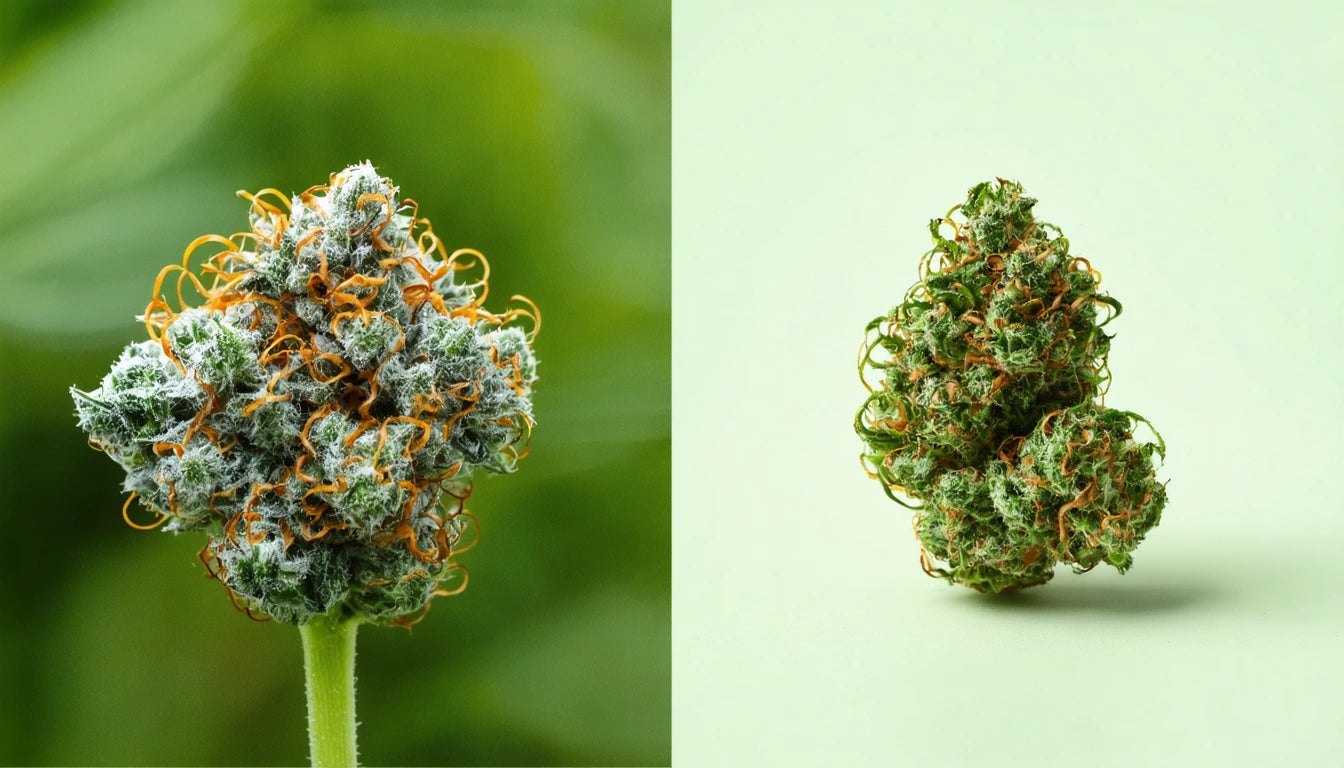Table of Contents
Understanding the Differences Between Cannabis Bract and Calyx
When examining cannabis flowers, enthusiasts and cultivators often encounter confusion regarding plant anatomy, particularly when distinguishing between the bract and calyx. These structures are frequently misidentified or used interchangeably, leading to misconceptions about cannabis morphology. This guide clarifies the cannabis bract vs calyx debate with accurate botanical information.
Cannabis Flower Anatomy Basics
Cannabis plants have complex reproductive structures, especially in female plants which produce the cannabinoid-rich flowers sought after for consumption. Understanding the basic components of cannabis flowers provides context for distinguishing between bracts and calyxes.
Female cannabis flowers consist of several key structures:
- Stigmas: Hair-like structures that capture pollen
- Bracts: Modified leaves that enclose and protect reproductive organs
- Calyxes: The true sepals of the flower
- Trichomes: Resin glands that produce cannabinoids and terpenes
- Pistils: The female reproductive organs comprising the stigma and ovary
As explained in this overview of cannabis plant basics, these structures work together in the plant's reproductive cycle while also serving as the primary sites for cannabinoid production.
The Cannabis Bract Explained
The bract is a specialized leaf-like structure that surrounds and protects the female reproductive parts of the cannabis plant. Bracts are the small, teardrop-shaped structures that envelop the reproductive organs and eventually form what many incorrectly call the calyx.
Key characteristics of cannabis bracts include:
Physical Appearance
Bracts are typically green, teardrop-shaped structures covered densely with trichomes. They form the bulk of what consumers recognize as the cannabis bud or flower.
Function in the Plant
Bracts serve primarily as protective structures for the ovule (unfertilized seed) and other reproductive components. They shield these delicate parts from environmental stressors and potential damage.
Cannabinoid Concentration
Importantly for consumers and producers, bracts contain the highest concentration of cannabinoid-rich trichomes on the entire plant, making them the most potent part of the cannabis plant.
The Cannabis Calyx Explained
The true calyx in cannabis is much smaller and less conspicuous than commonly believed. In botanical terms, the calyx refers specifically to the sepals of a flower, which are the small, usually green structures that form the outermost whorl of a flower.
Actual Structure and Location
In cannabis, the true calyx is a translucent, thin layer of cells at the base of the ovule, nested deep within the bract. It's not readily visible to the naked eye and requires close examination to identify.
Botanical Definition
According to proper botanical classification, as detailed in this comparison of calyxes and pollen sacs, the calyx consists of sepals that protect the flower bud before it opens.
When cultivating cannabis, proper storage is essential for preserving these delicate structures. Many growers use specialized storage containers with secure caps to maintain the integrity of harvested flowers and prevent degradation of the bracts and their valuable trichomes.
Key Differences Between Bracts and Calyxes
Understanding the cannabis calyx vs bract distinction requires recognizing several key differences:
| Feature | Bract | Calyx |
|---|---|---|
| Size | Larger, visible to naked eye | Tiny, microscopic |
| Location | Surrounds reproductive organs | Base of the ovule within the bract |
| Function | Protection and cannabinoid production | Initial protection of developing flower |
| Trichome density | Very high | Minimal to none |
| Visibility in harvested cannabis | Prominent feature of buds | Not visible without magnification |
Why These Differences Matter for Growers
Distinguishing between bracts and calyxes is more than a botanical technicality; it has practical implications for cannabis cultivation and assessment:
Harvest Timing
Experienced growers monitor bract development and trichome maturation to determine optimal harvest times. Understanding which structures to observe prevents harvesting too early or too late.
Potency Assessment
Since bracts contain the highest concentration of cannabinoids, being able to identify healthy, well-developed bracts helps growers assess potential potency.
Plant Health Monitoring
Changes in bract appearance can indicate plant stress, nutrient deficiencies, or pest problems, allowing for timely interventions.
As noted in this guide on optimizing cannabis growth, proper identification of plant structures helps with diagnosing nutritional needs and health issues.
Common Misconceptions in Cannabis Terminology
The cannabis industry and culture have perpetuated several misconceptions about plant anatomy:
The "Calyx Confusion"
The most prevalent misconception is referring to the bract as the calyx. This error has become so widespread that even experienced growers often use the term incorrectly.
Sugar Leaves vs. Bracts
Another common confusion involves distinguishing between small sugar leaves and bracts. While both can be trichome-covered, they are distinct structures with different functions.
"Swollen Calyxes"
References to "swollen calyxes" as indicators of maturity are actually describing enlarged bracts, which swell as the flower matures or when seeds develop inside.
These misconceptions are discussed in this article on cannabis terminology evolution, which tracks how cannabis language has developed over time.
Practical Applications of Understanding Plant Morphology
Beyond academic interest, correctly identifying cannabis structures has several practical applications:
Better Growing Practices
Understanding the role of bracts in cannabinoid production helps growers optimize light exposure, nutrients, and other factors that influence trichome development.
More Accurate Communication
Using correct terminology facilitates clearer communication among cultivators, researchers, and consumers about cannabis quality and characteristics.
Informed Breeding Programs
Breeders who understand true plant morphology can make more informed selections when developing new strains with specific bract characteristics that may influence potency, terpene profiles, or yield.
As the cannabis industry matures, botanical accuracy becomes increasingly important for scientific research, medical applications, and consumer education. The distinction between cannabis bract vs calyx represents just one example of how improved botanical knowledge enhances our understanding of this complex and valuable plant.











Leave a comment
All comments are moderated before being published.
This site is protected by hCaptcha and the hCaptcha Privacy Policy and Terms of Service apply.